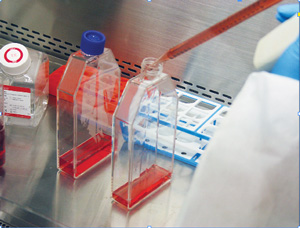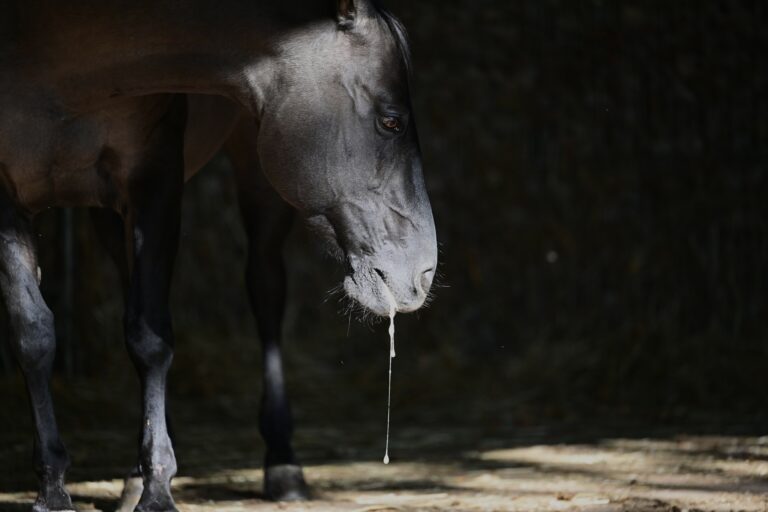One thing about veterinary practice: It never stands still. In fact, the constant onslaught of new products, procedures and technologies might be one of the most challenging things about trying to establish a profitable business.

In which new “toys” should you invest? Which are going to enhance your practice’s profitability? Which are intriguing but probably not profitable, and which are the potential duds that either won’t be cost-effective or won’t be in demand by your clients?
It’s an ever-renewing jigsaw puzzle for equine practices. Here’s how a few prominent practices have tackled the issue.
Reason #1: Filling a Need
Bill Rood, DVM, JD, is one of the founding partners of Rood and Riddle Equine Hospital in Lexington, Kentucky, a sprawling facility employing some 50-odd veterinarians and an army of other staff. The size of the practice, which focuses on racehorses and high-performance sport horses, has allowed it to invest in some high-end equipment, including an MRI suite and facilities for nuclear scintigraphy.
“Whatever we add to our practice at this point has to fill a need,” Rood said. “We have a million dollars invested in our MRI machine and the suite to hold it, and we’re very happy we did it. It has paid for itself in three years.
“Our stem cell lab was set up with the help of the University of California/Davis and completed in February 2010. The investment was on the order of six figures. We’re harvesting stem cells from bone marrow and injecting tendons and ligaments. It also has some applications in the hoof. This past fall, stem cell procedures took off, and we anticipate the interest will only become stronger.”
Brendan Furlong, MVB, MRCVS, owner of B.W. Furlong and Associates, a seven-veterinarian practice focusing on sport horses in Oldwick, New Jersey, and in Wellington and Ocala, Florida, notes that he is always interested in purchases which “make our job easier.” He added, “Profitability is important, of course, but when it comes to diagnostic equipment, it’s also just about having the best images because that helps us help the horse.”
Reason #2: Staying Competitive
Kathie Davidson, the hospital administrator for the Toronto Equine Hospital, a three-veterinarian practice based close to Woodbine Racetrack, noted, “It’s definitely important to stay competitive. You have to keep up with everyone else. Clients will inquire about certain products or technologies or drugs, and we always look into it. But for us to invest, it has to be something that will benefit the practice significantly.”
The Toronto Equine Hospital’s decision to install a nuclear scintigraphy suite was a good example of a well-thought-out investment, Davidson said. “That was a big decision,” she recalls. “But we were one of the first private hospitals to offer bone scans, and it allows us to pinpoint problems no one can find.”
Rood discusses a recent purchase for his practice: the equipment to perform ELISA testing for salmonella in horses. “[The disease is] usually used in food production,” he explained. “We did 1,000 samples last spring with borrowed equipment, and decided to buy it. It makes the practice more efficient because we can now have results in 24 to 36 hours, which helps the clients.”
Furlong acknowledged, “I operate in a very competitive market, and I like to be a leader. Our practice was the first in the Northeast to have a standing MRI, and it was a scary investment at the time. When you’re the first to add a new technology, you up the ante for other practitioners, which can be a good thing. I think it’s important to stay current.”
Reason #3: The Art and the Science
“We want to be on the cutting edge,” said Rood. “Profitability is not always the sole motivation [for investing in a new technology]. We would like everything to be profitable, but we are veterinarians because of both the science and the art of it. Sometimes it’s just something that piques your interest.”
A good example of this is another recent acquisition for Rood and Riddle: an Enduro-NEST (NASA Equine Support Technology) sling, which has the potential not only to support horses with non-weight-bearing lamenesses, but also to serve as a support system during anaesthesia, surgery and recovery. “We’ve used it a little, but we expect it will pay for itself in the future,” said Rood.
Kelly Tisher, DVM, vice president of Littleton Equine Medical Center in Littleton, Colorado, said, “It’s not always about the bottom line. Sometimes [an investment in a new product or technology] is more about being on the forefront. We’re a referral hospital, so it’s important for us to be equipped with the latest and greatest, stuff that a smaller practice might not have.”
“The buzz is definitely regenerative medicine,” said Furlong. “PRP, IRAP, stem cells–they’re all around to stay, and all of them require instrumentation. We’re seeing a great demand for arthroscopic equipment that can get into small places. [When making purchasing decisions], I consult with some friends in human medicine, and incorporate their thoughts into my decision-making.”

Reason #4: It Makes Financial Sense
“We don’t invest in everything, obviously,” said the Toronto Equine Hospital’s Davidson. “It has to be worthy–by which I mean it has to do what it’s supposed to, be supported by solid science, and we have to have the opportunity to try before we buy. Most salespeople will lend you the product for a week or so, or at least do a demo.
“It has to live up to its claims,” he continued. “We won’t buy an inferior drug or product–it’s not about margin. We will shop around for the best price, sure, but not at the expense of quality.”
Said Furlong, “We do look at return on investment, but how quickly we want to realize that varies by the size of the purchase. When we installed our MRI unit, I would have been happy to have it paid for in three to five years, but as it turns out I paid it off in a little over two years. Because we were the first in the area, there was no competition, and we ended up doing a lot more scanning in those first two years than we had initially anticipated.
“We calculated the per-use cost of the unit and estimated how many procedures we could do with it in a year, and then we ended up adjusting the cost to the client three or four times in the beginning, because we could see the break-even was more easily achievable than we’d first thought.”
Rood noted, “With the economy the way it has been the last couple of years, we didn’t buy nearly as many toys in 2010 as we have done in the past. We also used some of that budget to invest in a major sponsorship for the World Equestrian Games, which was right on our doorstep in Lexington. That was the largest marketing venue we’ve ever done, but what a unique opportunity. We really couldn’t ignore it. Eighty-two thousand people went through our pavilion at the Kentucky Horse Park in 13 days.
Budgeting for Acquisitions
Equine practices have many different ways of deciding whether the budget can handle the acquisition of a new technology, procedure or medication. At Rood and Riddle, an executive committee must approve any purchase over $10,000, and there is a definite preference for dealing with vendors with whom they’ve previously had good dealings.
“We have an operating budget and a capital budget,” said Rood, “and we’ve stuck to that budget in recent years. I think having that capital budget is the key to success when you’re buying equipment.”
At B. W. Furlong and Associates, it’s Furlong, as sole owner, who calls the shots, though he says he values input from the veterinarians and technicians on his team. “We have a separate bank account for equipment and repairs, and my practice manager advises me on the state of the purse-strings,” he said. “Often, it’s not really purchasing something new, it’s repairing or replacing a piece of equipment that is worn out, or deciding to do an upgrade. Things like portable ultrasound machines keep improving, and it can be tough to decide sometimes how often you need to move up to the next generation.
“We do try to get some trade-in value on older models when we do upgrade, and that can help. I also try to budget ahead by a year or two for larger purchases. I’m now at the point where the equipment and repair account is healthy enough that it can handle most of the unexpected costs. I save some money by not purchasing those expensive maintenance contracts, and rely instead on the money in that account to take care of repairs and replacements that might be needed.”
The take-home message? Smart budgeting is necessary not only for buying sexy new toys, but for maintaining, replacing and upgrading those essentials on which your day-to-day practice hinges. That has never been more true than in the past couple of years, and it is likely to continue to be true for awhile longer. While veterinary technology continues to expand, one has to weigh the cost of offering new techniques or procedures against an economic climate that has resulted in clients owning fewer horses and looking for less expensive options for treating them. If your practice is financially secure and you can afford to give a new acquisition time to deliver ROI, you will be in a much better position to stay on the cutting edge.
SIDEBAR
Buy Now, Profit Later
Most equine practices have little trouble finding new “toys” in which to invest; if a visit from a salesperson doesn’t alert them to the newest products and technologies available, conferences, tradeshows and advertising will. What will fit best into your own practice is a very personal decision; however, here are a few recent innovations worth investigating.
Dynamic Video Endoscopy This equipment takes respiratory endoscopy away from the artificiality of the treadmill and allows you to assess respiratory function under real racing or training conditions, often providing insight into airway obstructions or abnormalities that might not reveal themselves in the lab. The wireless equipment is contained in a small pack that can be carried by the rider or strapped to a jog-cart.
High Speed Video for Podiatry The combination of high-speed video equipment and specialized software to analyze the resulting data is having a significant impact on gait analysis and lameness and hoof balance evaluations.
The Lameness Locator This system by Equinosis helps to quantify subtle lameness that can be difficult to pinpoint by eye, even by the most experienced veterinarian. Three wireless motion sensors are applied to the horse (with self-stick veterinary bandage, temporary adhesive, or in the case of the poll sensor, by attaching it to a head bumper used for shipping), and data from the horse in motion is then sent to a computer tablet. The resulting graphics identify the limb or limbs where gait abnormalities are occurring, and their degree of severity. Can be used with the horse in-hand, longeing or being ridden.
Bone Marrow Aspirate Concentrate A recent offshoot of stem cell therapies, BMAC is harvested from the sternum or hip, but instead of shipping the sample off for days or weeks of lab culture, it is spun down and injected back into the horse on the same day of harvest. This simplified procedure is less costly to the client, faster and may be applicable for cartilage repair as well as tendon and ligament injuries. It is often used in combination with Platelet Rich Plasma.








